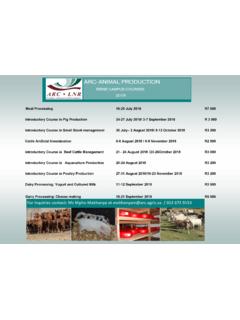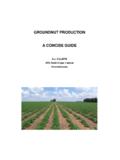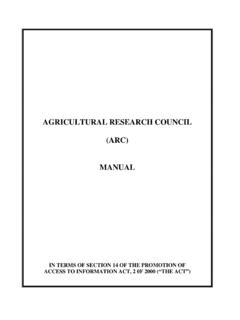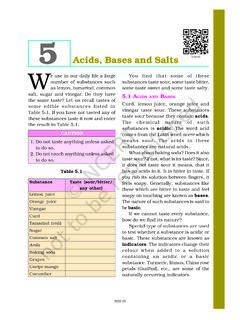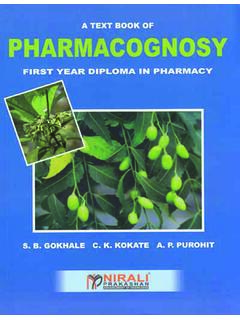Transcription of GROUNDNUT PRODUCTION A CONCISE GUIDE
1 GROUNDNUT PRODUCTION A CONCISE GUIDE CILLIERS ARC Grain Crops Institute Potchefstroom 2 Introduction Groundnuts are a popular source of food throughout the world, including South Africa. In many countries groundnuts are consumed as peanut butter or crushed and used for the GROUNDNUT oil or simply consumed as a confectionary snack roasted, salted or in sweets. In other parts of the world they are boiled, either in the shell or unshelled. Groundnuts are produced in the tropical and subtropical regions of the world, on sandy soils. The PRODUCTION practices vary from highly sophisticated commercial ventures in the western world to more traditional cropping practices in third world countries. Yields vary from about 400 kilograms to several tonnes per hectare depending on PRODUCTION system and PRODUCTION area.
2 In South Africa, groundnuts are grown in the summer rainfall regions under irrigated or rainfed conditions. Resource limited farmers, especially in the northern and eastern parts of South Africa grow groundnuts mainly for own consumption. Groundnuts are an important source of nutrition in the northern KwaZulu-Natal and Mpumalanga areas. The crop can also contribute to more viable and sustainable cropping systems in other parts of the country. It is expected to become more important for the following reasons: It is an excellent rotation crop which can replace maize as a monoculture crop since it enriches the soil with nitrogen. Secondly it is a crop with high economic value which can fetch a high price on local markets.
3 GROUNDNUT PRODUCTION requires more management skills than many other crops. Successful farmers are those who apply the prescribed management practices throughout the PRODUCTION process. Soil requirements The GROUNDNUT plant produces runners (horizontal stems) which in turn produce flowers at each node. These flowers self-pollinate and produce an anchor or peg which penetrates the ground. The GROUNDNUT pod is produced underground at the tip of the pegs. The topsoil must thus have a low clay content (less than 20%) with a loose structure so that the peg may penetrate the soil freely. Soils with a high clay percentage in the topsoil may cause the GROUNDNUT pegs to break at harvest. Soil compaction can also be a problem if the fine sand fraction of the topsoil is high.
4 This situation can be aggravated in soils where the organic residues are low. The seedbed should be deep, without compaction layers, to accommodate the GROUNDNUT plants root system. Shallow soils must be avoided due to the low water retention capacity, as well as the possibility of water logging. Soils with a high potential for the PRODUCTION of groundnuts are thus typically deep (900-1200 mm), structureless yellow, yellow-red or red soils with a sandy loam to sandy 3 texture in the topsoil, without physical limitations, such as compaction. Suitable soil forms are Avalon, Bainsvlei, Clovelly, Hutton, Pinedene and Glencoe. Moisture requirements Runner type groundnuts are unsuitable for PRODUCTION in South Africa because of the longer growth season and the higher moisture requirements of these types.
5 The only groundnuts suitable for South African conditions are the Spanish types with an upright growth habit and short growth season. It is difficult to form an impression of where groundnuts would be best adapted in South Africa by referring only to rainfall distribution. However, in order to illustrate the adaptation of groundnuts in terms of rainfall, Potchefstroom can be used as an example. The long term average rainfall in Potchefstroom is 659 mm per year. The period July to end of September has a long term average rainfall of only 32 mm. At this time moisture in the soil is limiting, so in order to plant groundnuts in October, 45 mm of additional water is required. The average rainfall for October is 46 mm and planting in October is possible.
6 However, due to the large variation in rainfall patterns from year to year, from 3 mm in 1961 to 151 mm in 1951, this month also has limitations. The probability of receiving 5 mm of rain every fifth day is only 16%. During November this position improves somewhat with the probability of 10 mm of rain being 45%, which still being rather low is, however, better than 16% in October. Sufficient moisture in the soil at planting time is essential. Too much rain at harvest, however, can reduce the quality of groundnuts if the crop is left to dry in the field. Temperature requirements Groundnuts originate from the tropical areas in South America and require a growth period with high temperatures of which at least 160 days are frost free.
7 The lower limit for germination of groundnuts is around 18 C. Temperatures between 20-30 C result in 95% germination. However at 33 C this declines to 84%. Optimum germination temperatures are thus between 20-30 C with a minimum of 18 C. The temperature of the water absorbed by the seed is also critical as far as germination is concerned. If the water temperature is initially low and gradually increases we find reduced germination. Planting in cold wet soil is therefore unsuitable. Planting in warm soils results in fast germination and healthy seedlings. Do not plant in dry soil and irrigate with cold water. 4 The warmer the environment, the faster the plant reaches the reproductive phase.
8 Flower formation is closely related to mean temperature on condition that the variation between day/night temperature does not exceed 20 C. The most flowers are formed at a day temperature of 27 C, while a warm day (29 C) and a cool night (23 C) gives the highest pod formation. Growth requirements and nutrition Substantial evidence exists to show that groundnuts respond to additional fertiliser applications, even though in rural situations this is not imperative. Groundnuts are adapted to a soil with a pH (H20) of 5,3 or higher, if the pH is higher than 3,5 to , certain elements become unavailable eg. iron and zinc. Being a leguminous crop, groundnuts can fix atmospheric nitrogen (N) with the aid of root bacteria.
9 For this reason this crop is not dependent on nitrogen fertilisation. Root nodules which fix nitrogen effectively have a pink coloured appearance when dissected. Groundnuts with effective root bacteria do not need additional nitrogen. It has often had been accepted that groundnuts prefer residual phosphorus to freshly applied P. In rural fields, however, the level of P is usually low and it should be applied. Like other crops, groundnuts require sufficient levels of potassium for normal growth and development. An over supply of potassium in the soil can induce a calcium deficiency, which is reflected in a lower yield and quality. In situations where the soil potassium level is low, additional potassium can be applied.
10 In most cases, approximately 10 kg ha-1 of potassium is probably sufficient although it is very seldom required. Calcium (Ca) is very important for seed development. Groundnuts are particularly susceptible to a calcium deficiency in the soil. Where a crop is grown on calcium deficient soils, the producer will have a direct seed loss as well as indirect damage to the seed which is not always visible. Seed produced under such conditions is not suitable for planting. Seedlings are often misshapen with a low vigour and mostly the heart or embryonic axis is damaged to such an extent that no germination takes place. In situations where less than 100 mg kg1 Ca is present in the soil, gypsum is added at a rate of 200 kg ha-1.
